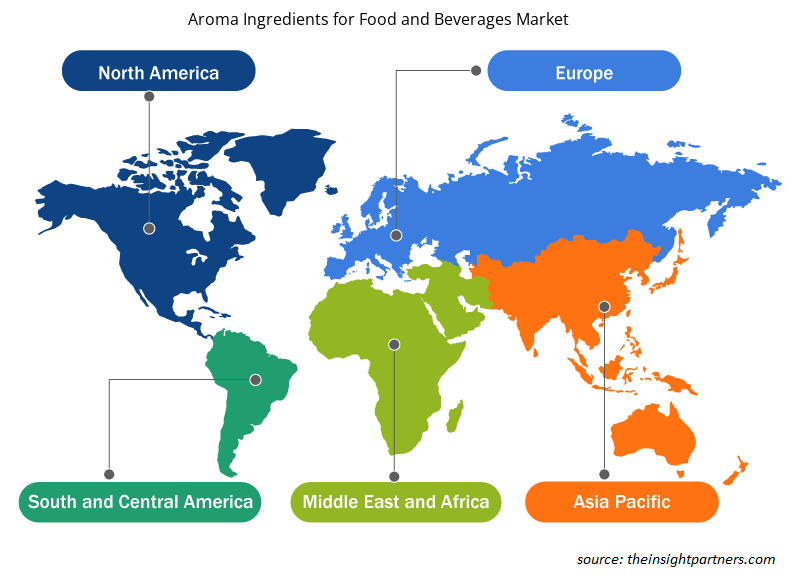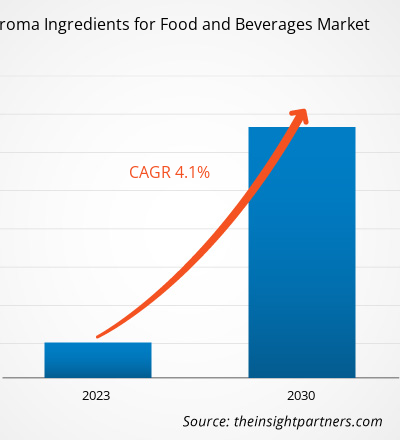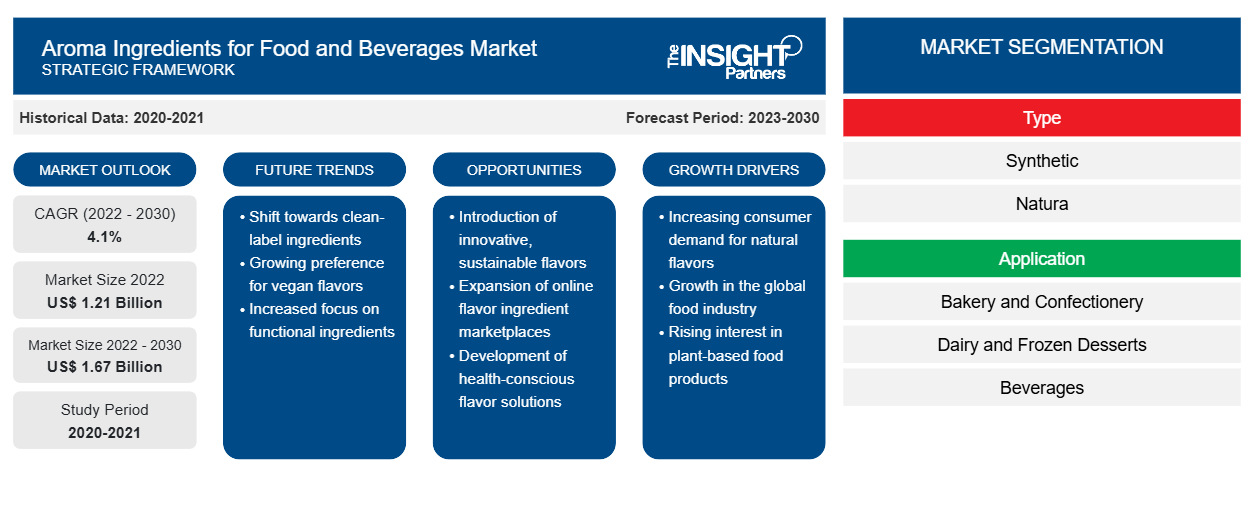[연구보고서] 식품·음료용 향료성분 시장 규모는 2022년 12억 1,000만 달러에서 2030년 16억 7,000만 달러로 성장할 것으로 전망되며, 2022년부터 2030년까지 연평균 성장률 4.1%를 기록할 것으로 추산됩니다.
시장 통찰력 및 분석가 관점:
향료 성분은 천연에서 추출한 성분에서 분리하거나 석유에서 화학적으로 추출합니다. 이러한 성분은 과자와 짭짤한 간식부터 알코올 및 비알코올 음료에 이르기까지 다양한 식품 및 음료 품목의 풍미와 향 프로필을 형성하는 데 중요한 역할을 합니다. 식품 및 음료 산업에서 향료 성분의 중요성이 커지고 주요 시장 참여자의 전략적 이니셔티브가 식품 및 음료 시장의 향료 성분을 주도하는 주요 요인입니다. 또한 독특하고 이국적인 풍미와 향 경험에 대한 소비자 수요 증가와 추출 및 합성 기술의 발전은 시장 환경을 형성하는 데 더욱 도움이 됩니다. 그러나 식품 및 음료 산업에서 향료 성분 사용과 관련된 규제적 제약은 식품 및 음료 시장 성장을 방해합니다.
성장 동인 및 과제:
식품 및 음료 산업의 아로마 성분 제조업체는 소비자를 유치하고 시장 지위를 강화하기 위해 합병 및 인수, 협업 및 기타 전략적 개발에 상당히 관여합니다. 제빵 및 제과, 유제품, 냉동 디저트 및 기타 품목을 생산 및 판매하는 다양한 식품 및 음료 시설에서 아로마 성분에 대한 수요가 증가함에 따라 주요 업체는 전 세계적으로 시장 지위를 강화하기 위한 전략적 이니셔티브를 채택하게 되었습니다. 예를 들어, 2023년 11월 BASF SE는 Isobionics Natural alpha-Bisabolene 98 및 Isobionics Natural (-)-alpha-Bisabolol 99라는 두 가지 새로운 천연 아로마 성분을 출시한다고 발표했습니다. 이러한 제품 개발은 식품 및 음료 시장의 아로마 성분을 주도하고 있습니다.
시장의 주요 업체들은 생산 시설을 확장하고 유통업체와 계약을 맺어 시장 지위를 강화하고 있습니다. 예를 들어, 2021년 12월 Tilley Distribution, Inc.는 Phoenix Aromas 및 Essential Oils와의 합병을 발표했습니다. 이 합병은 규제 및 기술 지원을 제공하는 데 경험이 있는 팀과 함께 신규 및 기존 소비자 기반에 고품질 제품을 제공하는 데 도움이 될 것입니다. 또한, 2021년 7월 Symrise AG는 B2B 고객을 위한 맞춤형 소스, 딥, 드레싱, 시럽 및 음료 농축액을 생산하는 캐나다 기업인 캐나다에 본사를 둔 Giraffe Foods Inc.를 인수했습니다. 이 인수는 북미에서 Symrise의 Flavor & Nutrition 부문을 확대하여 시장 지위와 고객 기반을 강화할 것입니다. 따라서 주요 시장 업체의 전략적 이니셔티브는 식품 및 음료 시장의 글로벌 아로마 성분 성장을 촉진합니다.
다양한 식품 및 음료 응용 분야에서 향료 성분의 생산 및 사용은 다양한 정부 기관에서 규제합니다. 식품의약국(FDA) 및 유럽 식품 안전 기관(EFSA)과 같은 규제 기관은 소비자 안전과 제품 품질을 보장하기 위해 향료 성분 사용에 대한 엄격한 지침과 표준을 부과합니다. 예를 들어, 유엔 환경 계획은 식품 향료의 사용을 규제했습니다. 이 규정은 식품에서 향료 및 향료 성분 또는 향료를 올바르고 통제되고 안전하게 사용하기 위한 모든 필수 조건을 제공합니다. 또한 식품의약국(FDA)은 식품에 사용할 수 있는 식품 향료에 대한 규정을 부과했습니다. 이러한 규제 요구 사항을 충족하려면 광범위한 테스트 및 문서화 프로세스가 필요하며, 이는 제조업체에 시간과 비용이 많이 소요될 수 있습니다. 향료 성분에 대한 승인 프로세스는 길고 복잡할 수 있으며, 이는 업계 내 혁신과 제품 개발을 더욱 방해할 수 있습니다.
귀하의 요구 사항에 맞게 이 보고서를 사용자 정의하세요
이 보고서의 일부 또는 국가 수준 분석, Excel 데이터 팩을 포함하여 모든 보고서에 대한 사용자 정의를 무료로 받을 수 있으며 신생 기업 및 대학을 위한 훌륭한 혜택과 할인 혜택을 이용할 수 있습니다.
- 이 보고서의 주요 시장 동향을 알아보세요.이 무료 샘플에는 시장 동향부터 추정 및 예측까지 다양한 데이터 분석이 포함됩니다.
보고서 세분화 및 범위:
"2030년까지의 식품 및 음료용 글로벌 아로마 성분 시장 분석"은 시장 동향과 성장 기회에 중점을 둔 전문적이고 심층적인 연구입니다. 이 보고서는 유형 및 응용 분야별 세부 시장 세분화를 통해 시장 개요를 제공하는 것을 목표로 합니다. 이 시장은 최근 높은 성장을 보였으며 예측 기간 동안 이러한 추세가 지속될 것으로 예상됩니다. 이 보고서는 전 세계적으로 식품 및 음료용 아로마 성분 소비에 대한 주요 통계를 제공합니다. 또한, 식품 및 음료용 글로벌 아로마 성분 시장 보고서는 전 세계적으로 시장 성과에 영향을 미치는 다양한 요인에 대한 정성적 평가를 제공합니다. 이 보고서에는 또한 시장의 주요 기업과 그들의 주요 전략적 개발에 대한 포괄적인 분석이 포함되어 있습니다. 시장 역학에 대한 여러 분석도 포함되어 주요 원동력 요인, 시장 동향 및 수익성 있는 기회를 식별하는 데 도움이 되며, 이는 차례로 주요 수익 주머니를 식별하는 데 도움이 됩니다.
식품 및 음료 시장 예측을 위한 향료 성분은 주요 회사 간행물, 협회 데이터, 데이터베이스와 같은 다양한 2차 및 1차 연구 결과를 기반으로 추정됩니다. 또한 생태계 분석과 포터의 5가지 힘 분석은 시장에 대한 360도 관점을 제공하여 전체 공급망과 시장 성과에 영향을 미치는 다양한 요소를 이해하는 데 도움이 됩니다.
세그먼트 분석:
식품 및 음료 시장의 향료 성분은 유형과 용도에 따라 세분화됩니다.유형, 시장은 합성 및 천연으로 나뉩니다. 합성 세그먼트는 테르펜, 알데히드, 지방족 및 기타로 더 세분화됩니다. 천연 세그먼트는 에센셜 오일 , 허브 추출물, 올레오레진 및 기타로 더 세분화됩니다. 2022년에 합성 세그먼트는 식품 및 음료 시장 점유율에서 가장 큰 향료 성분을 차지했습니다. 천연 세그먼트는 2022년부터 2030년까지 가장 높은 CAGR을 기록할 것으로 예상됩니다. 합성 향료 성분은 식품 및 음료에서 발견되는 천연 향을 모방하는 화학 화합물입니다. 식품 및 음료 산업에서 이러한 성분에 대한 수요의 급증은 여러 요인에 기인할 수 있습니다. 첫째, 합성 향료 성분은 풍미 프로필에서 일관성을 제공하여 천연 성분의 변화에 관계없이 제품의 맛이 항상 동일하도록 합니다. 이러한 일관성은 브랜드 아이덴티티와 소비자 만족에 중요합니다. 둘째, 천연 향료 성분에 비해 비용 효율성을 제공하여 제조업체, 특히 대규모 생산에서 더 쉽게 접근할 수 있습니다. 또한, 풍미 과학의 발전으로 천연 풍미를 밀접하게 복제하는 합성 성분이 개발되어 익숙한 맛에 대한 소비자 선호도를 충족시키는 동시에 독특한 풍미 조합을 제공하게 되었습니다. 결론적으로, 천연 성분의 안정성과 가용성에 대한 우려와 규제 압력으로 인해 식품 및 음료 산업에서 합성 향료 성분의 채택이 더욱 촉진되었습니다.
지역 분석:
시장 범위는 북미, 유럽, 아시아 태평양, 중동 및 아프리카, 남미 및 중미의 5개 주요 지역에 초점을 맞춥니다. 아시아 태평양은 2022년 식품 및 음료용 아로마 성분 시장 점유율이 가장 높았으며, 시장 가치는 약 4억 2,500만 달러였습니다.유럽은 두 번째로 큰 점유율을 차지했고 그 뒤를 북미가 뒤따랐습니다.
유럽에서 아로마 성분에 대한 수요가 증가하는 것은 이 지역의 풍부한 요리 전통과 프리미엄 및 장인 제품에 대한 선호도 증가에 기인할 수 있습니다. 유럽 전역에서 요리 전통과 요리에 대한 강력한 문화적 감사가 있습니다. 유럽의 소비자는 고품질 재료와 정통 풍미를 중시하여 감각적 경험을 향상시키는 아로마 성분에 대한 수요가 증가하고 있습니다. 이러한 미식의 우수성에 대한 강조는 유럽 소비자의 까다로운 취향에 맞춰 자연스럽고 지속 가능한 출처에서 공급되는 프리미엄 아로마 성분에 대한 시장이 성장하는 결과를 가져왔습니다. 또한 유럽에서 더 건강하고 자연스러운 음식 옵션에 대한 관심이 증가함에 따라 시장 성장이 촉진되었습니다. 유럽 소비자는 유기농 및 식물성 식단을 받아들였으며, 종종 특정 야채, 곡물 및 콩과 같은 강렬하거나 익숙하지 않은 맛과 향이 나는 재료를 통합했습니다. 이러한 건강을 의식하는 선택을 더 매력적으로 만들기 위해 식품 제조업체는 아로마 성분을 사용하여 강렬하거나 불쾌한 맛과 향을 완화하여 제품이 천연 및 클린 라벨 트렌드를 고수하는 동시에 광범위한 소비자 수용을 유지하도록 합니다. 이러한 수요는 유럽 전역의 음식 품질, 맛, 감각적 경험에 대한 인식과 맞물려 있으며, 이 모든 요소가 해당 지역의 음식과 음료에 향료 성분을 도입하는 데 기여하고 있습니다.
북미에서 식품 및 음료 시장의 향료 성분은 편의식품 및 포장식품 판매 증가, 확립된 식품 산업, 기능성 음료에 대한 소비자 선호도 급증에 기인합니다. 향료 성분은 이러한 제품에서 제품의 전반적인 향을 향상시켜 소비자에게 더욱 매력적으로 만드는 데 중요한 역할을 합니다. 천연 및 클린 라벨 제품에 대한 소비자 선호도가 증가함에 따라 시장 성장에 더욱 기여했습니다. 건강과 웰빙에 대한 인식이 계속 높아짐에 따라 소비자는 천연 향료 성분이 포함된 제품을 점점 더 찾고 있습니다. 이로 인해 식품 및 음료 제조업체는 과일, 허브, 향신료와 같은 천연 자원에서 추출한 향료 성분을 통합하여 소비자 수요를 충족하게 되었습니다. 또한 식품 및 음료 부문의 프리미엄화를 향한 식품 및 음료 시장 추세가 수요 증가에 기여했습니다.
식품 및 음료 시장을 위한 아로마 성분 지역 통찰력
Insight Partners의 분석가들은 예측 기간 동안 식음료용 아로마 성분 시장에 영향을 미치는 지역적 추세와 요인을 철저히 설명했습니다. 이 섹션에서는 또한 북미, 유럽, 아시아 태평양, 중동 및 아프리카, 남미 및 중미의 식음료용 아로마 성분 시장 세그먼트와 지리에 대해서도 설명합니다.

- 식품 및 음료 시장을 위한 아로마 성분에 대한 지역별 특정 데이터 얻기
식품 및 음료 시장 보고서 범위를 위한 아로마 성분
| 보고서 속성 | 세부 |
|---|---|
| 2022년 시장 규모 | 12억 1천만 달러 |
| 2030년까지 시장 규모 | 16억 7천만 달러 |
| 글로벌 CAGR (2022-2030) | 4.1% |
| 역사적 데이터 | 2020-2021 |
| 예측 기간 | 2023-2030 |
| 다루는 세그먼트 | 유형별로
|
| 포함된 지역 및 국가 | 북아메리카
|
| 시장 선도 기업 및 주요 회사 프로필 |
|
식품 및 음료 시장 참여자를 위한 아로마 성분 밀도: 비즈니스 역학에 미치는 영향 이해
식품 및 음료용 아로마 성분 시장은 소비자 선호도의 변화, 기술 발전, 제품의 이점에 대한 인식 증가와 같은 요인으로 인해 최종 사용자 수요가 증가함에 따라 빠르게 성장하고 있습니다. 수요가 증가함에 따라 기업은 제품을 확장하고, 소비자의 요구를 충족하기 위해 혁신하고, 새로운 트렌드를 활용하여 시장 성장을 더욱 촉진하고 있습니다.
시장 참여자 밀도는 특정 시장이나 산업 내에서 운영되는 회사나 기업의 분포를 말합니다. 주어진 시장 공간에 얼마나 많은 경쟁자(시장 참여자)가 존재하는지 그 규모나 총 시장 가치에 비해 나타냅니다.
식품 및 음료용 아로마 성분 시장에서 운영되는 주요 회사는 다음과 같습니다.
- 국제 향료 및 향수 주식회사
- 센시언트 테크놀로지스 주식회사
- T 하세가와 주식회사
- 바스프 SE
- V 마네 필스 사스
면책 조항 : 위에 나열된 회사는 어떤 특별한 순서에 따라 순위가 매겨지지 않았습니다.

- 식품 및 음료 시장을 위한 아로마 성분의 주요 주요 업체 개요를 알아보세요
산업 발전 및 미래 기회:
보도자료에 따르면, 식품 및 음료용 향료 성분 시장에서 활동하는 주요 업체가 취한 몇 가지 이니셔티브는 아래와 같습니다.
- 2023년 3월, BASF SE는 중국 잔장에 있는 새로운 공장과 독일 루트비히스하펜에 있는 멘톨과 리날룰 하류 공장에 대한 투자를 발표했습니다. 이 투자는 독일과 말레이시아에서 BASF의 아로마 성분 가치 사슬 입지를 확대하고 다양화하며 고객의 성장 기회를 지원할 것입니다.
경쟁 환경 및 주요 회사:
International Flavors & Fragrances Inc, Sensient Technologies Corp, T Hasegawa Co Ltd, BASF SE, V Mane Fils Sas, Symrise AG, Firmenich International SA, Archer-Daniels-Midland Co, Kerry Group Plc, Berje Inc는 식품 및 음료용 향료 성분 시장 보고서에 소개된 주요 기업 중 일부입니다. 글로벌 시장 기업은 고객 수요를 충족하기 위해 고품질 제품을 제공하는 데 중점을 둡니다.
- 과거 분석(2년), 기준 연도, CAGR을 포함한 예측(7년)
- PEST 및 SWOT 분석
- 시장 규모 가치/거래량 - 글로벌, 지역, 국가
- 산업 및 경쟁 환경
- Excel 데이터세트
최근 보고서
관련 보고서
사용 후기
구매 이유
- 정보에 기반한 의사 결정
- 시장 역학 이해
- 경쟁 분석
- 고객 인사이트
- 시장 예측
- 위험 완화
- 전략 기획
- 투자 타당성 분석
- 신흥 시장 파악
- 마케팅 전략 강화
- 운영 효율성 향상
- 규제 동향에 발맞춰 대응





















 무료 샘플 받기 - 식품 및 음료 시장을 위한 아로마 성분
무료 샘플 받기 - 식품 및 음료 시장을 위한 아로마 성분